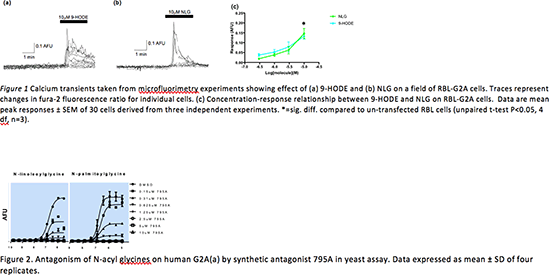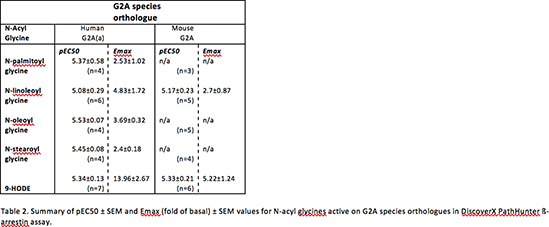| 021P London, UK 8th European Workshop on Cannabinoid Research |
Identification of medium chain N-acyl glycines as GPR132 (G2A) receptor agonists
Introduction: The N-acyl amides are a family of endogenous signalling lipid molecules typically consisting of an acyl chain conjugated to a biological amine (which may be dopamine, an amino acid, etc). The prototypical member of this family, N-arachidonoyl ethanolamine, exerts biological activity through the cannabinoid receptors [1]. We show that the activity of this family of molecule extends to the orphan GPR132 (G2A) receptor, by demonstrating agonist activity of medium chain N-acyl glycines.
Method: Rat Basophilic Leukemia (RBL) cells stably expressing human G2A(a) were loaded with Fura-2 AM and microfluorimetry experiments performed to measure agonist-induced calcium mobilisation. Data was analysed using unpaired students T-test to compare RBL-G2A with RBL parental. For yeast experiments, human, rat, mouse, and zebrafish G2A receptors were stably integrated into modified yeast strains containing yeast-human G-protein chimeras. Enzyme mediated hydrolysis of fluorescein di-β-D-glucopyranoside was used to measure agonist-dependent yeast growth [2]. The DiscoverX PathHunter assay was used to measure agonist-induced βarrestin-2 association with human and mouse G2A.
Result: In the calcium microflourimetry experiments N-linoleoyl glycine (NLG) had equal agonist potency as the reported G2A endogenous agonist 9-hydroxyoctadecadienoic acid (9-HODE) (Figure 1) [3]. In yeast and βarrestin-2 association assays all G2A species orthologues tested were sensitive to medium chain N acyl-glycines (Table 1 and 2). N-palmitoyl glycine had higher potency than 9-HODE in the yeast assay, whereas 9-HODE was more potent than any medium chain N-acyl glycine tested in the βarrestin-2 association assay. Finally, we used a G2A antagonist to demonstrate inhibition of G2A agonism by N-acyl glycines on human G2A(a) (Figure 2).
Conclusion: We identify medium chain N-acyl glycines as agonists of the G2A receptor.
[1] Devane, W. A. et al. (1992). Science, 258(5090), 1946-1949.
[2] Dowell, S. J., & Brown, A. J. (2009). Methods Mol Biol, 552, 213-229. doi:10.1007/978-1-60327-317-6_15
[3] Obinata, H. et al. (2005). J Biol Chem, 280(49), 40676-40683. doi:10.1074/jbc.M507787200




